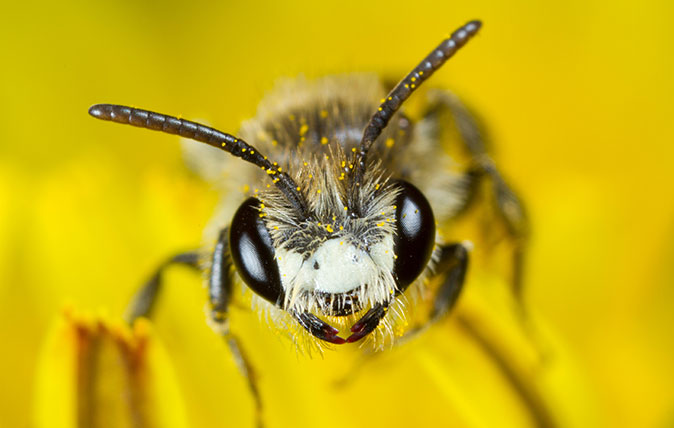Curious questions: How do you swat a fly?
Houseflies are a health hazard, but attempts to swat them have to contend with the insect's exceptional defense mechanism, finds Martin Fone.


Suetonius, in his biography of Domitian, noted that at the beginning of his reign the Roman Emperor would spend hours in seclusion every day, doing nothing but catch flies and stab them with a stylus. When asked whether someone was in the room with the emperor, Vibius Crispus retorted, 'not even a fly', a quip that has stood the test of two millennia.
In 2009, Barak Obama astounded the world with his ability to deal with a pesky fly. Midway through a televised interview with John Harwood on CNBC on the vexed question of financial regulation, he became increasingly distracted by the presence of a fly. Curling and raising his right hand as the insect landed on the left armrest of his chair, he slapped it against his left, killing the insect outright and then continued with the interview, a demonstration of the sort of attention to detail and precision that is welcome in a leader.
A fly buzzing around can be an unwelcome distraction and intensely irritating. As someone who believes that every creature has a right to life and a role to play in our eco-system, I find that waving my arms around is enough to signal my irritation and to persuade the insect to seek pastures new. A fly showing interest in a plate of food is another matter.
Musca domestica, the housefly, has long been associated with a lack of hygiene and the transmission of disease. The Book of Exodus relates how the Lord sent “a grievous swarm of flies into the house of Pharoah, and into his servants’ houses, and into all the land of Egypt: the land was corrupted by reason of the swarm of flies” (8.24), an early weapon of mass destruction. Physiologically, they can do nothing other than offend our sense of hygiene. A fly’s taste receptors, known as chemonsensilla, are located on its lower legs and feet and the only way that it can sample food to determine what tickles its fancy is by wandering over it.
When this gastronomic tour brings flies to their chosen meal, they will start to consume it. As they do not have teeth, they regurgitate digestive juices to break food down into liquid form and suck it up with their proboscis.
Worse still, their food flushes through their digestive system very quickly and is soon excreted. Some authorities suggest that they defecate every time they land.
To prevent all this, my weapon of choice is a small rectangular sheet of vented plastic attached to a handle a little more than a foot long, looking rather like a tennis racquet sketched by Picasso.
Exquisite houses, the beauty of Nature, and how to get the most from your life, straight to your inbox.
It was an American entrepreneur from Decatur, in Illinois, Robert Montgomery, who came up with the first commercially available flyswat, although he called it a fly-killer. Patented on January 9, 1900, (US patent No 640,790), it consisted of a piece of rectangular wire netting with the bottom ends folded over to form right-angled triangles and attached to a wooden handle. Montgomery claimed it to be 'a cheap device of unusual elasticity and durability'.
It was extensively advertised, described in Lady’s Home Journal in 1903 as a device that 'kills without crushing and soils nothing'. Montgomery soon lost interest in killing flies, selling the rights to his invention to John Bennett, better known for inventing the beer can, and it was he who improved the design by sewing around the edges of the net.
In 1905, the state of Kansas was overrun with a biblical plague of flies, raising public health concerns, as well as being a source of considerable irritation. To alert the public of the dangers presented by the flies, the state’s Secretary of Health, Samuel Crumbine, launched a campaign urging Kansans to “swat the fly”, adapting the popular chant of “swat the ball” he had heard at a Topeka softball match.
Rising to the challenge, a local schoolteacher, Frank Rose, created a 'fly bat', consisting of a piece of screen attached to a piece of wood, thousands of which were distributed for free at organised events around the state. They became known as flyswats and the name has stuck ever since.
With a large area with which to hit the fly and holes which minimise the disruption to air currents that would otherwise alert it to its impending doom, you would think that the odds are heavily stacked in my favour when I wield a modern flyswat.
Far from it. Is my pitiful strike rate down to slow reactions, and poor eye-hand coordination, or is the fly particularly adept at avoiding the swat?
This intriguing question exercised the mind of Michael Dickinson, a professor of bioengineering at the California Institute of Technology, and his investigations culminated in a paper published in Current Biology in 2008.
Using a high-resolution digital camera with a speed of 5,000 frames a second, he lowered a swatter-like disc, tilted at a fifty-degree angle, onto a fruit fly and recorded in minute detail what happened.
The fly, Dickinson found, had significant defence mechanisms that protected it against attack. Although they are stationary, its eyes give it 360-degree vision which enables it to detect the direction from which danger is coming.
Upon receipt of this, its brain then rapidly processes this sensory information, in less than 200 milliseconds, to determine what is the most appropriate evasive action to take and adjust its centre of mass, relative to whichever pair of its six legs will lead its jump to safety.
If it detects danger from the front, the fly moves its middle legs forward, leans back, and then raises and extends its legs to jump backwards. Sensing danger coming from one side, it keeps its middle legs still, leans its body in the opposite direction and jumps. An attack from the rear causes the fly to move its legs slightly backwards and then jump forwards.
These reactions are not automatic, allowing the fly to abort or adjust its direction of flight in response to further information received. Irrespective of what the fly is doing, it still has time to scramble and take what it considers to be the most appropriate evasive action.
This explains why it is so difficult to swat a fly but will these insights into its neurosensory responses help us to improve our hit rate?
Avoid aiming at the fly’s starting position, Dickinson advised. Instead, aim a little bit forward of that, anticipating the likely direction that the fly will travel when it first spots danger. Flies are also unable to detect slow movements and so it may just be possible to creep up on them before administering the fatal blow.
For those who wish to eschew the thrill of the chase, flypaper, sticky paper impregnated with an alluring scent, or a fly bottle containing a scented liquid or the fly zapper, much loved by restaurants which electrocutes an errant insect, all provide a solution, albeit static.
Alternatively, nature offers its own solution with its diverse range of carnivorous plants, effective and fun to grow.
One thing is certain; the problem will not go away.

Credit: Alamy
Curious Questions: Are bees really busy?
We've all used the phrase 'busy as a bee' – but is it justified? Or are bees just as liable
After graduating in Classics from Trinity College Cambridge and a 38 year career in the financial services sector in the City of London, Martin Fone started blogging and writing on a freelance basis as he slipped into retirement. He has developed a fearless passion for investigating the quirks and oddities of life and discovering the answers to questions most of us never even think to ask. A voracious reader, a keen but distinctly amateur gardener, and a gin enthusiast, Martin lives with his wife in Surrey. He has written five books, the latest of which is More Curious Questions.
